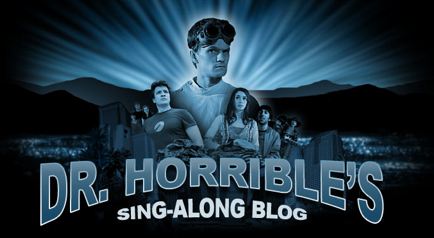One of the more interesting experiments that came out of frustrated creativity during the Writer’s Strike was Joss Whedon’s Dr Horrible’s Singalong Blog:Â Â A three-part musical with some very well known actors in the lead roles.Â

Until an interview with Knowledge @ Wharton we didn’t have a lot of the financial detail, other than it was done with a SAG low budget or experimental contract.
There are a couple of interesting observations in the article. The one that immediately caught my “I don’t believe advertising can support new media” prejudice was this comment about where the money came from:
 iTunes has been a great boon for us. And the DVD has done quite well — although I’d love to bump that up more. Streamed [online video] with advertising is probably the smallest revenue. Whether that’s a viable monetization scheme … is the question. In some ways it acts as an advertisement and in some ways it might be pulling people away from bothering to download it or to buy the DVD.
What’s funny here is that Whedon’s experience was that the “free” (with advertising support) was useful in promoting the paid downloads and DVD – people paying for media! Â That’s the complete reverse of the more theoretical positions held by many that the content will be free but some other income stream will “subsidize it” (like advertising has for the last 50-60 years).
It’s also satisfying to know that even when it was being streamed on Hulu with advertising – horribly irrelevant and repetitive advertising – it was the best selling download on iTunes. The pay-for-download version was being purchased through the iTunes store even though there was a free alternative (if you like to see the same ad over and over again).Â
The budget was something over $200,000, which is more than had been previously guessed, but total revenue has now been “more than” double that. Even considering that a lot of the income over $200,000 went to actors and department heads who had worked for nothing, that’s still not too bad overall. Â It also means the production budget is within the range for similar content – with similar level stars – as a musical would for cable. For ease of the Math, let’s say the total budget was $350,000.
Given that the range for network shows is 25-65c per viewer/per show from advertising revenue and cable rates are lower, let’s be generous and go with the 25c per view figure. At that rate, the show would have had to have enjoyed a cable audience of 1.5 million to have covered its costs.Â
If we were to be more realistic about the advertising rate – they were network rates after all – the audience would have needed to be around 2 million (cumulative) to have funded the show.Â
Cable can certainly get the numbers: Monk, The Closer and Burn Notice all enjoying audiences of over 5 million on USA and TNT. Shows around the 2 million audience are The Daily Show, Real Housewives of OC, and  Intervention. Very few musicals and not much drama/comedy content!
The one thing we don’t know is what the total audience numbers are across iTunes, Hulu, other online outlets, and the DVD release, but we do know that $6.50 (their share after the reported figure Apple take) for a 45 minute show is better revenue than any other model has provided on a “per minute” basis. Sure, they added additional content so that people who might have already seen the show on Hulu or have it from iTunes still have a reason to buy the DVD. (Directly sold DVDs could bring in a higher per viewer revenue, but not if there’s a distributor or Amazon CreateSpace in the middle.)
Of course, I thought it would have been a show that would have been perfect through Open TV Network. All the benefit of having people delivered each episode as it comes out, with the ability to make a small charge for each download. 15c an episode would have bought in more than a cable showing would and definitely be worth it. Plus when there were DVD Extras they could have been offered to existing fans via their feeds.
Regardless of how, I believe it’s clear that some part of “new media” has to disintermediate the conversation between viewer and producer, without another editor in the middle. And that’s going to require a little direct revenue. We tip for service, why not pay for entertainment?